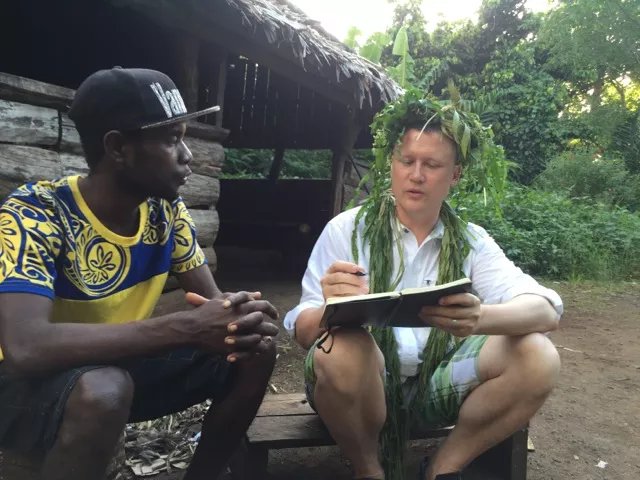Linguist K. David Harrison to Document Plants, Languages in Vanuatu

Linguist K. David Harrison (right) consults with Chris Nevehev, a speaker of the Aneityum language, in Vanuatu.
K. David Harrison is heading to the South Pacific islands of Vanuatu to document the plants and languages of local communities.
“We’re working with these communities to build knowledge tools that help ensure the survival of their languages and cultures,” says Harrison, associate provost for educational programs and professor of linguistics.
Harrison was recently awarded a four-year grant from the National Science Foundation (NSF) to advance these efforts, in collaboration with scientists from The New York Botanical Garden (including Sean Thackurdeen ’12, who will lead the botanical part of the project) and The University of Hawaii, Manoa. As a linguist, the opportunity to work closely with botanists and biodiversity specialists excites Harrison.
“There’s a natural synergy there,” he says. “Much of humanity’s knowledge about animals and plants, the natural world, is only found in small languages that are themselves in danger.”
Vanuatu is a linguistic and biodiversity hotspot, with the highest concentration of languages per persons anywhere in the world, says Harrison. But its plants and fungi are poorly documented, its culture and languages imperiled by globalization.
Harrison's botanist colleagues will complete the first-ever floristic survey of Vanuatu, exploring plants that are new to scientists but familiar to locals. Harrison will examine eight of the 110 languages that are spoken in the islands, record names of the plants and other words in those languages, and add the data to the collection of talking dictionaries hosted at Swarthmore.
“In some cases, we're helping to create the first-ever internet presence for these languages,” says Harrison. “It’s bringing them across the digital divide, in a way that fully respects and attributes their knowledge as being their intellectual property.”
Harrison has traveled to Vanuatu twice to lay groundwork for the project, and the grant allows him to bring faculty colleagues and students to join the study (as he recently did in Mexico and Micronesia). The first goal, he says, is to build a network in the communities to “de-mystify” your presence and foster trust.
“I’ve been very impressed with the Vanuatu culture and people,” says Harrison, “the generosity of sharing knowledge, the cultural richness, the biodiversity. It’s just an amazing place to do this type of research.”
“It’s a chance to do something of scientific value,” he adds, “while at the same time supporting a positive social change.”
The NSF grant project officially began in July, dovetailing with Harrison’s start as associate provost at Swarthmore — an opportunity for which he has high hopes.
“Swarthmore has been an ideal research and teaching home for me for 15 years, allowing me to link my fieldwork on endangered languages with our classrooms,” says Harrison. “I’m thrilled now to serve as associate provost, to help develop initiatives on campus, expand opportunities for embedded learning, and brainstorm new ways to map and visualize our curriculum."



